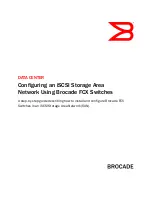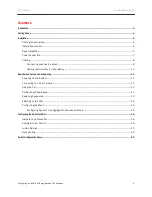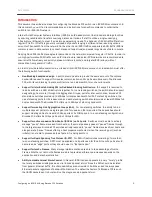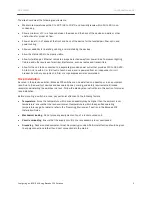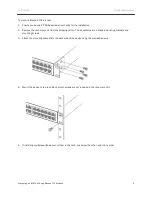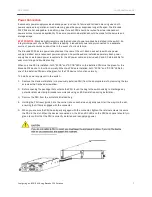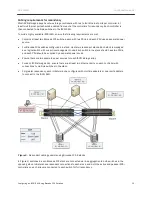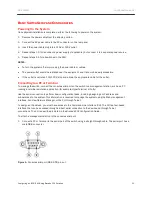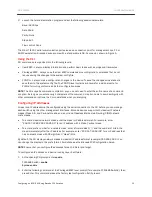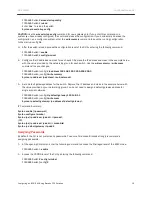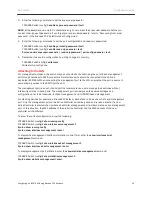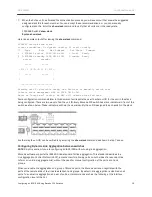
DATA CENTER
CONFIGURATION GUIDE
Configuring an iSCSI SAN Using Brocade FCX Switches
3
I
NTRODUCTION
This document describes the steps for configuring the Brocade FCX switch in an iSCSI SAN environment. In
this document, you will find recommendations and instructions for specific commands to optimize the
switch for an iSCSI SAN network.
Internet Small Computer Systems Interface (iSCSI) is an IP-based protocol that links data storage facilities
by ensuring reliable data transfers over long distances. It allows IT staff to utilize a single underlying
infrastructure (Ethernet) to meet IT and storage networking needs. The behavior of iSCSI traffic differs from
regular IP traffic. IP traffic is generally composed of packets ranging in different sizes, requiring various
amounts of bandwidth from the network. On the other hand, iSCSI traffic encapsulates SCSI traffic (SCSI is
commonly used in data centers to connect disks and tape drives) and sends large blocks of data in bursts.
Carrying block SCSI traffic places greater demands on the network compared to regular IP traffic. In order to
run high-performance SCSI traffic over an IP infrastructure, dedicated iSCSI networks are recommended to
ensure traffic flows freely and quickly between initiators (clients) and targets (iSCSI arrays) without
competition from general IP traffic.
In order to provide reliable operation in a mission-critical iSCSI SAN environment, an ideal switch must offer
the following switch functionality:
•
Non-Blocking backplane design.
A switch should be able to provide the same amount of backplane
bandwidth required to support full duplex communication on ALL ports simultaneously. The Brocade
FCX, with its non-blocking line-rate architecture, is an ideal switch for such environments.
•
Support for Inter-Switch Linking (ISL) or Dedicated Stacking Architecture.
ISL support is required to
link all switches in a SAN infrastructure together. For non-stacking switches, the switch should support
designating one or more (through Link Aggregation Groups) ports for inter-switch links. Brocade FCX
stand-alone switches provide up to 40Gbps full-duplex bandwidth for ISL. For stacking switches, the
use of stacking ports for ISL is assumed, and each stacking switch should provide at least 20Mbps full-
duplex bandwidth. The Brocade FCX offers up to 64Gbps of stacking bandwidth.
•
Support for creating Link Aggregation Groups (LAG).
For non-stacking switches, the ability to bind
multiple physical ports into a single logical link for use as an ISL is required. These switches should
support creating LAGs of at least 8x 1Gbps ports or 1x 10Gbps port. In a non-stacking configuration, a
Brocade FCX offers 8x 1Gbps ports or 4x 10Gbps for LAG.
•
Support for active or passive Flow Control (802.3x) on ALL ports.
Switches must be able to actively
manage “pause” frames received from hosts, or they must passively pass all “pause” frames through
to the target arrays. Brocade FCX switches actively respond to “pause” frames received from hosts and
also generate “pause” frames offering a backpressure mechanism when the receiving port (such as
initiator) is not able to process data as fast as it is being sent to it.
•
Support for Rapid Spanning Tree Protocol (R-STP).
For SAN infrastructures consisting of more than
two non-stacking switches, R-STP must be enabled on all ports used for ISLs. All non-ISL ports should
be marked as “edge” ports or they should be set to “fast port-span.”
•
Support for Jumbo Frames.
Many storage implementations are able to take advantage of Jumbo
Frames. Whether or not Jumbo frames are able to provide performance increases depends on the
application and data characteristics.
•
Ability to disable Unicast Storm Control.
In General,
iSCSI can send packets in a very “bursty” profile
that many switches misdiagnose as a viral induced packet storm. Since the SAN should be isolated
from general Ethernet traffic, the viral possibilities are non-existent. Switches need to always pass
Ethernet packets regardless of bandwidth utilization. The default behavior of a Brocade FCX is such
that iSCSI packets sent in bursts will not be diagnosed as a packet storm.

